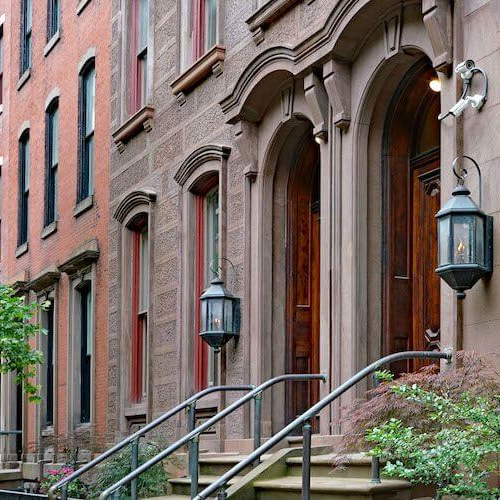Multigenerational homes: What it's like living in one
Feb 25, 2024
•4-minute read
In the last 5 decades, the number of Americans living in households with multiple generations under one roof has quadrupled, according to the Pew Research Center. More than 59 million people live in multigenerational households, which are homes with two or more adult generations. Multigenerational homes offer a unique dynamic. Whether it's parents living with their adult children or a “skipped generation” of grandparents and grandchildren, this dynamic can be rewarding – and challenging.
If you’re contemplating a change in your living arrangement or just curious, keep reading to learn more about the rise of multigenerational housing and its potential advantages and disadvantages.
What is a multigenerational home?
Multigenerational homes (also known as multi-gen homes) typically house more than one adult generation of family members in the same home. The living arrangements can include grandparents, parents and their adult children. It can also include extended family members and in-laws.
Who lives in a multi-gen home?
On average, multigenerational homes have four people living together. The age ranges in these households can be quite diverse, with an age gap of almost 40 years between the oldest and youngest family members. Often, as many as four generations live together under one roof.
What do families say about living in multigenerational homes?
To better understand what it’s like to live in a multigenerational home, Rocket Mortgage® Research surveyed households identified as multigenerational.
Many participants reported living in multigenerational homes for most of their lives. Over 31% reported living in a multigenerational home all their lives.
When asked about the familial makeup of their households, parents and adult children were the family roles most frequently represented in the survey.
Adults living in multigenerational homes sometimes juggle multiple family roles, like being an adult child and an oldersibling. However, many family members take on several roles. Everyone contributes their unique strengths and plays an important part in the communal life of the home. Some 60.9% of survey respondents identified primarily as a parent or aparental figure, and 35.6% identified as an adult child. 3.5% of survey respondents indicated their main role as a grandparent or a grandparent figure.
Reasons for living in a multigenerational home
Survey respondents were asked to select up to three reasons for living in a multigenerational home. We’ve compiled the top three reasons from respondents:
- 8% said home affordability and saving money were their primary concerns
- 2% said they wanted to spend more time with family
- 9% said providing care for older family members was a significant factor
Of the 48.8% who described financial reasons as their primary motivator for multigenerational living, housing costs were their biggest concern. 40.2% of these respondents attributed their decision to share a home with their family to either the expensive housing market in their area (21.6%) or the need for multiple incomes to afford a home (18.6%).
33.9% admitted they would struggle to save money without the financial cushion of multiple incomes. 5.2% identified thereduced cost of older adult care as their primary reason, and 2.5% pointed to child care as their main motivation.
The challenges of living in a multigenerational home
Like any type of housing arrangement, living in a multigenerational home has advantages and challenges.
If you treasure your privacy and enjoy quiet evenings, you may want to consider an alternative housing setup. While a healthy percentage of people in multigenerational households acknowledged the benefits of this living situation, 56.5% of survey respondents said that if they had a choice, they’d prefer to live in their own home or only with their immediate family.
The drawbacks of sharing the same living space with several generations can include privacy concerns. 26.4% of respondents reported privacy concerns as an issue. 19.9% of respondents also cited differences in opinions and beliefs as a chief frustration in a large family home.
47.6% of respondents emphasized the importance of respecting each other's privacy and personal space to help reduce tensions.
Household dynamic in multigenerational homes
A significant portion of respondents reported no noticeable changes in their family dynamics. Over half of the surveyparticipants said that living with multiple generations had no positive or negative effects on their mental health.
However, we discovered some intriguing differences when we analyzed and delved into the opinions of adult parents and children on multigenerational living.
Of the adult parents surveyed, 30% said the most compelling advantage of living in a multigenerational home is the extra time they spend with their family. Parental adults are more likely to report improvements in their mental health and intergenerational relationships than adult children.
Of the adult children surveyed, 30% said shared responsibility for household expenses was the most compellingadvantage of multigenerational living. 13.1% said not having the freedom to branch out and explore new opportunities was the biggest disadvantage of living in a multigenerational household.
And unlike adult parents who reported positive effects on their mental health, adult children are more likely to indicate the opposite.
Advice for anyone considering multigenerational housing
We have lived-in advice survey respondents had to share for anyone contemplating living in a multigenerational home: Talk to people you know who live in a multi-gen home and listen closely to their perspectives. Knowing what challenges you may encounter can help you determine whether this living arrangement will work for you.
Read through our recommendations to improve your experience living in a multigenerational home:
- Establish clear rules and boundaries
- Strive to respect each other’s opinions and perspectives
- Practice patience
- Build stronger relationships
The bottom line
Living in a multigenerational home offers a unique living arrangement that celebrates the strengths and contributions of multiple generations under one roof. People embrace multigenerational living for several reasons, including financial support, more time spent with family and managing the cost of care for a household’s oldest and youngest members.
Multigenerational living can provide valuable support, shared experiences and a sense of togetherness for all family members. Are you ready to switch from contemplating multigenerational housing to buying a home that can fit you and generations of your family under one roof? Start on a mortgage application today to discuss your financing options.
Methodology
To understand the lives of the 18% of the US population living in multigenerational homes, Rocket Mortgage surveyed 750 adult Americans that live with grandparental figures and/or are 25 years old or older living with parental figures. Multigenerational home residents were asked about the makeup of their household, religious affiliations, familial roles, and household dynamic. They were also asked about the reasons why they live in multigenerational homes including the advantages and disadvantages. This survey was conducted May 4, 2023.

Carla Ayers
Carla Ayers is former section editor for Rocket Homes and is a Realtor® with a background in commercial and residential property management, leasing and arts management. She has a Bachelors in Arts Marketing and Masters in Integrated Marketing & Communications from Eastern Michigan University.
Related resources
8-minute read
How to move out of your parents’ house in 18 steps
Ready to move out of your parents’ house, but not sure how? Follow our guide for tips on how you can become a financially responsible first-time homeow...
Read more

8-minute read
Multifamily investing 101: How to buy multifamily homes
Are you interested in multifamily investing? Learn the reasons to invest in multifamily real estate, your loan options and how to buy a multifamily property.
Read more
7-minute read
Best places to raise a family: A complete guide
Choosing where to live with your family is an emotional decision, but we’ve assembled the numbers that can help you find the best places to raise a family...
Read more